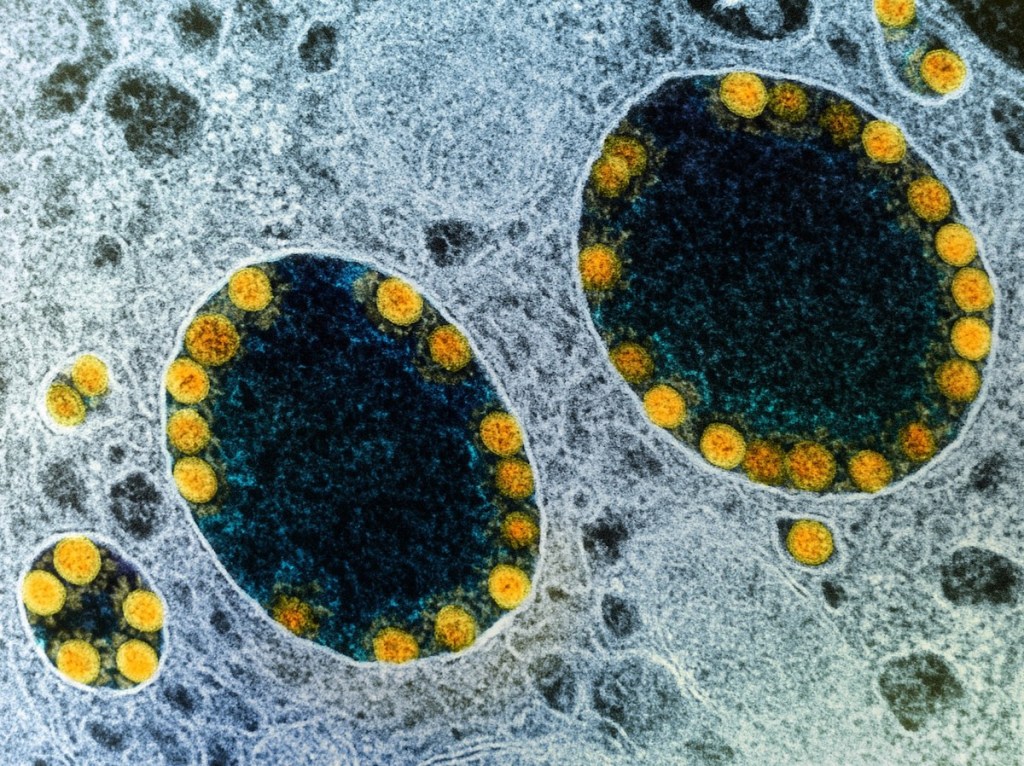At their most successful, viruses evolve to stick around and not kill their hosts, a hope the world holds for the newest SARS-CoV-2 variant — the B.1.1.529 or “Omicron” variant. The finding in South Africa announced on November 25 set off a stampede of events worldwide. While the United States took a break for Thanksgiving, stock exchanges plunged and many borders closed to southern African nations.
The new variant — the first to be labeled a “variant of concern” since Delta by the World Health Organization — was described by Brazilian bioinformatician Tulio de Oliveira, who heads two medical research facilities in South Africa, one of which is the Centre for Epidemic Response & Innovation. Samples from South Africa’s Gauteng province — which holds the city of Johannesburg — neighboring Botswana, and Hong Kong showed a variant with a high number of mutations that could possibly be more transmissible, evade innate immunity, and have an increased infectivity, he tweeted.
Though the news caused stock market indices from the Dow in the U.S. to the Hang Seng in Hong Kong to plummet hundreds of points, they inched back upward on Monday, but none recovered. The variant has not yet been detected in the United States — the closest at the moment is two cases in Ontario, Canada. But the genetic sequencing ongoing countrywide and in Santa Barbara County have stepped up their vigilance, said Dr. Henning Ansorg, the county’s health officer. He noted that California would increase testing at airports across California for U.S. citizens and legal residents returning from southern African states: South Africa, Botswana, Zimbabwe, Namibia, Lesotho, Eswatini, Mozambique, and Malawi, the eight countries from which travel was restricted to the U.S. starting November 29.
Ansorg has the responsibility in Santa Barbara County for COVID-19 requirements such as the indoor wearing of masks, which is a complicated decision, he indicated. “Public Health considers multiple factors when deciding whether or not to extend a mandate. There is still much to learn about the Omicron variant,” Ansorg said, “and we are not likely to see those impacts for a few weeks.” He pointed out that the effect of many of the variant’s mutations were unknown, and that labs were just starting to check whether it could evade the immunities built up from previous infection or vaccine. In the meantime, the best protection to COVID-19, including the new variant, he said, continues to be vaccination and face masks, especially masks that offer a tight fit and thorough coverage, such as the KN95.
“Right now, we’re all in that uneasy place,” said Dr. Lynn Fitzgibbons of the major unknowns about the new variant. “We’re aware that something has shifted, but we don’t yet have solid answers to these very important questions.”
Sign up for Indy Today to receive fresh news from Independent.com, in your inbox, every morning.
Dr. Fitzgibbons, an infectious-disease specialist and educator at Cottage Health, which has only one patient in its COVID ward at the moment, noted that the wastewater surveillance around the South African capital Pretoria showed a tenfold increase in the virus over the past 10-14 days. “Most concerning to me,” she said, “was just how quickly this variant has taken off in South Africa.” As well, on the two flights in the air from South Africa bound for Amsterdam when travel restrictions were imposed on Saturday, 10 percent of the passengers were verified to have Omicron, she said, which showed just how infectious the variant was. With the recent U.S. holiday, Fitzgibbons added, “unfortunately, it wouldn’t be surprising to learn that there are cases here that simply have not been sequenced yet.”
If downtown Santa Barbara were any gauge, epidemiologists may have something to worry about. A happy throng of people shopped, lines went out the doors, and restaurants were full this past weekend. Robin Elander, who heads Downtown Santa Barbara, said she was “very pleasantly surprised to see a ton of people strolling about,” and Talia Hankey of Lovebird Boutique reported having a “solid weekend” with a lot of people out and about the store’s De la Guerra Plaza location.
This time around, unlike Alpha and Delta, doctors, nurses, and hospitals can prepare for Omicron, Fitzgibbons said. The system for detecting variants worked, locating Omicron just as it was accelerating its spread. “That’s really new in this whole pandemic,” she said. “Very often, we’re seeing surges, and only retrospectively do we recognize variants and features of variants that are likely responsible.” By mid-December, clinicians should have reliable information on the variant’s effect against vaccines and how severe the disease it produces might be.
Hospital rates had increased in South Africa over the past several weeks, which may or may not have anything to do with Omicron, according to the World Health Organization. And anecdotally, Fitzgibbons said, physicians in South Africa had noted some patients had symptoms that were milder with this variant. “But we need the data,” she said. “The plural of ‘anecdote’ is not ‘data.'”
Correction: This story was corrected to reflect that Dr. Tulio de Oliveira (@Tuliodna) summarized important aspects of the new variant on November 25, after the finding was announced by South Africa’s National Health Laboratory Service (@NICD_SA) that day.
At the Santa Barbara Independent, our staff continues to cover every aspect of the COVID-19 pandemic. Support the important work we do by making a direct contribution.

